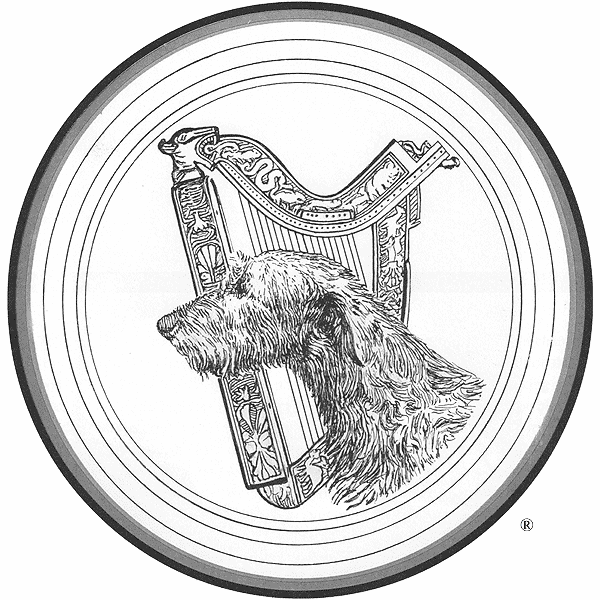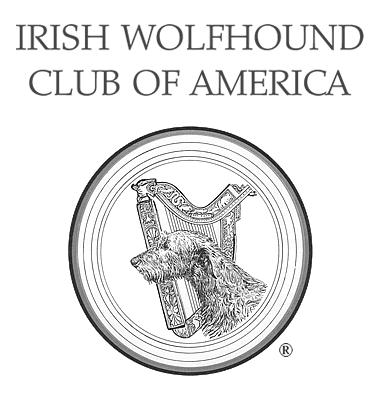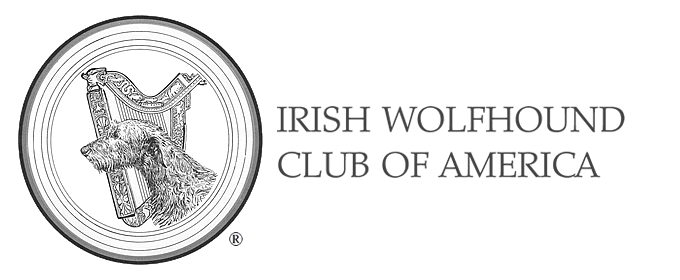Health Issues in Adult Irish Wolfhounds
While an Irish Wolfhound can get any illness any other dog is subject to, the breed does have a tendency towards certain diseases, including bloat, heart disease, bone cancer, lymphoma and pneumonia.
Bloat
Bloat, correctly called gastric dilatation, is often accompanied by twisting of the stomach, called volvulus. The two syndromes together, gastric dilatation-volvulus, are abbreviated GDV.
In bloat, gas accumulates in the stomach, causing the abdomen to swell. If you tap the dog's side with your finger, it sounds like a drum. The dog tries to vomit, but can't. Instead he makes a retching sound sometimes described as “ga-a-ack.” Once you've heard this sound, you aren't likely to forget it. As the stomach expands, it puts pressure on the diaphragm and on the veins passing through it to the heart, quickly causing the dog to go into shock. Bloat is truly an emergency and you must call the veterinarian immediately! If caught early, acupressure can help relieve the pressure but veterinary care is still necessary.
Volvulus is believed to occur when the spleen enlarges, possibly secondary to diminished circulation because of the bloat. The spleen is suspended along the outer curvature of the stomach, and is thought to weight the stomach down and flip it over. Acupressure will not help once volvulus occurs. Dogs with GDV deteriorate rapidly and the mortality (death) rate can be quite high even with intensive treatment if veterinary care is delayed. Fortunately, advances in emergency treatment and medical intensive care have improved survival rates, but only with prompt treatment.
No one knows exactly what causes GDV. A study may pinpoint one cause, only to be refuted by another researcher. Further information may be found at Purdue University College of Veterinary Medicine by doing a search for "bloat dog."
Heart Disease
The most common heart irregularity found in Irish Wolfhounds is an arrhythmia called atrial fibrillation, or A-fib. In older hounds it is sometimes considered of no clinical importance, but it can develop into congestive heart failure over a period of time, and should be monitored with chest x-rays and ECGs on a regular basis. In younger dogs it can develop into cardiomyopathy, a weakening of the muscles of the heart with subsequent enlargement of the heart and eventual failure. The most common early symptom is a light cough and loss of tolerance for exercise. Treatment with cardiac drugs can improve the heart function and maximize the quality of life for the dog. While no preventative has been proven, routine monitoring of your hound, even at a young age, with annual or semi-annual ECGs can detect heart disease in its early stages, when it is most responsive to treatment.
Bone Cancer
Bone cancer, osteosarcoma, or OSA, is a diagnosis no Wolfhound owner wants to hear. This highly aggressive cancer generally affects the bones of the legs: humerus, radius, femur and tibia. OSA weakens the bone, causing pain and can thin the bone until it breaks. Usually the first sign is limping, and may be accompanied by swelling and heat in the bone. Request the leg be x-rayed, even if the veterinarian doesn't think it is necessary. It may only be a sprain, but it is important to detect OSA as early as possible. If the x-ray is inconclusive, and the hound continues to limp, have the veterinarian re-x-ray the leg no later than two weeks after the first. Early detection is the key to any hope for treatment.
Treatment options at this time are limited and invasive and include removal of the affected portion of bone and replacement with a graft, amputation of the limb, radiation and/or chemotherapy. For owners who elect not to have surgery, pain alleviating radiation therapy and medical treatment are available.
The long term prognosis for survival after a diagnosis of OSA is poor, but better than in the past, and improved methods for pain control can give the hound a good quality of life for his remaining time.
Lymph Node Cancer
Cancer of the lymph nodes, lymphoma, affects all dogs, but certain breeds seem to have a higher incidence.
Lymphoma strikes early middle-aged dogs. Symptoms are often vague - not acting right, loss of appetite, unexplained weight loss - but can be dramatic with greatly enlarged lymph nodes suddenly appearing. Diagnosis is only accurately made with a biopsy and “staging” of the cancer. Staging tells the pathologist which form the cancer has taken (“T” or “B” cell) and how aggressive it is. Treatment options and prognosis depend upon staging.
With improved chemotherapy treatments some dogs live comfortably for up to two years.
Pneumonia
The most common cause of pneumonia in adult Wolfhounds is aspiration, or inhalation, of foreign material into the lungs. Other less common causes include fungal infections and bacterial infections secondary to kennel cough or other illnesses.
Aspiration pneumonia may be caused by gulping water or food, vomiting, or as a sequel to myasthenia gravis, a degenerative neurologic disease.
Regardless of the cause, pneumonia in Wolfhounds is medically difficult because it seems to come on so quickly. Hounds are apparently healthy and later the same day are running a high fever and having trouble breathing. They often refuse to lie down and stand with their head and neck extended. They may or may not cough. X-rays, if they show anything, are typical for pneumonia, with blotchy white areas in the lungs. Blood work will show an elevated white cell count.
A medical note: Most Wolfhounds I have seen have a lower than 'normal' white blood cell count, usually running five to seven thousand. A white cell count of ten thousand, therefore, is elevated even though the laboratory range may consider counts up to fourteen thousand 'normal.'
Pneumonia must be treated aggressively and for a sufficient period of time or the pneumonia will recur. Some pneumonias must be treated for two or even three months.
Anesthesia in Irish Wolfhounds
Irish Wolfhounds are sighthounds, in the same group as greyhounds, salukis and whippets. In the days of barbiturate anesthesia, surgery was considered a risky proposition for sighthounds. Barbiturates, like pentobarbital, are removed from the bloodstream by first going into the body fat, which most sighthounds possess little of. Wolfhounds generally carry a higher degree of fat which would give a greater margin of safety.
However, barbiturates are seldom used in veterinary anesthesia anymore, having been replaced by much safer products such as Propofol.
Injectable anesthetic dosages are calculated on a milligram per kilogram basis. It has been my experience that Wolfhounds generally require only one-half to two-thirds the calculated dose for induction. If the veterinarian keeps this in mind, anesthesia and surgery in Wolfhounds should not carry any greater risk than for any other veterinary patient.
© 2014 C.A. Krowzack, DVM
This page was last updated 08/04/2021.



